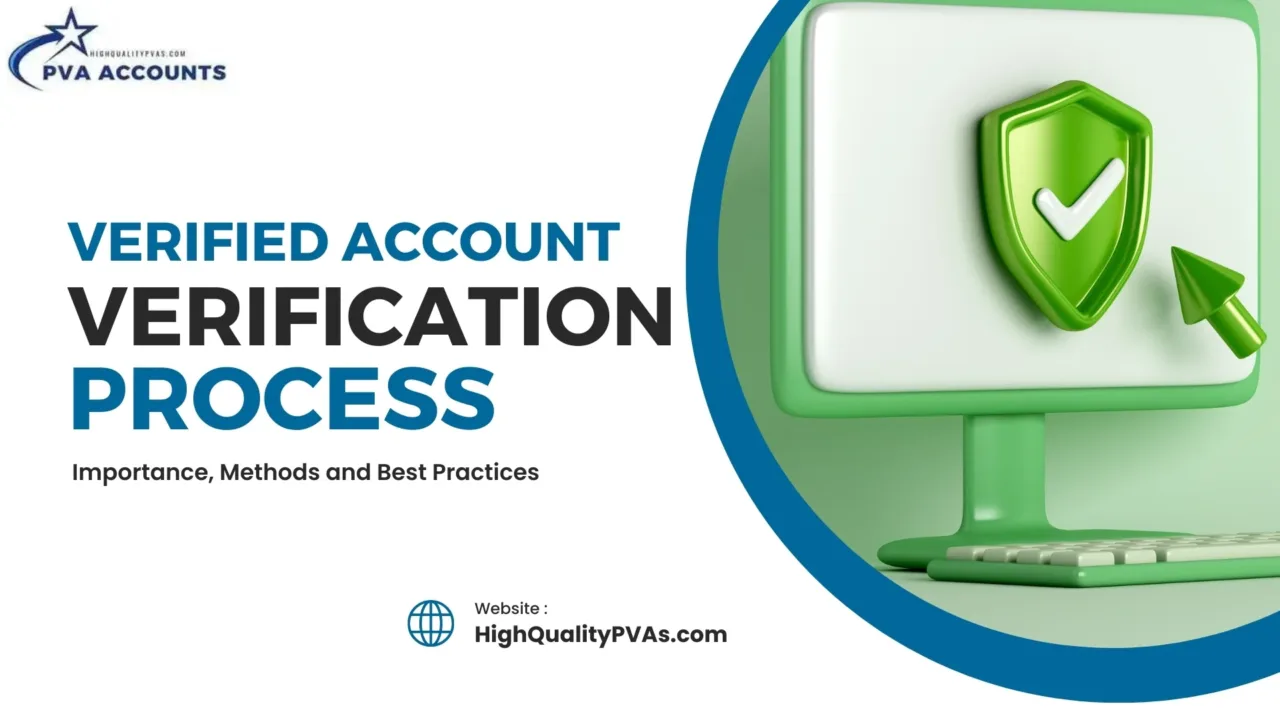
Account verification systems (account certification) play a crucial role in establishing authenticity and preventing fraudulent activities. Verification of an account process serves as a first line of defence against cybercriminals and ensures that only legitimate users have access to the services or platforms they are trying to use.
Account verification means making an unverified user profile a verified account by getting and verifying the confirmation code received via email or SMS to your phone number. The account verification process is an important aspect of ensuring security and trustworthiness on different online platforms, such as email and social media websites.
Two commonly used methods of account verification are telephone number verification and email address verification. Both phone number and email address verification methods provide an additional layer of security, helping to prevent fraud and unauthorized access to personal information.
By understanding the nuances of the account verification process, you can confidently enhance your online security, protect your digital identity, and navigate the evolving authentication protocols.
What is Account Verification?
Account verification is the process of confirming the phone number or identity of an individual or entity trying to create an account or log in to an online email account or social media platform.
Social networking services introduced electronic authentication, a critical step that involves verifying the user’s personal information, such as their name, address, telephone number, and government-issued identification, to ensure they are who they claim to be. By implementing robust account verification procedures, businesses can safeguard against fraud, protect user privacy, and maintain regulatory compliance.
Identity proofing and user authentication have become increasingly vital in enhancing the quality of online services and ensuring social media optimization.
Digital identity verification is necessary and plays a vital role in identity management. Verifying an individual or business’s account authenticity reduces fraud and spam. The verification process mitigates sockpuppetry, vandalism, trolling, bots, fake news (disinformation), and the risk of violating digital onboarding and identity confirmation.
Why is Verification Necessary for Online Accounts?
Verification is necessary to maintain a safe and respectful online environment. Platforms can build a community based on trust and authenticity by ensuring that users are real people, not bots or fake accounts. Verification is essential for social media platforms where the spread of misinformation, cyberbullying, and other digital threats can have severe consequences.
With the rise in cybercrime and identity theft, ensuring the security of our online accounts has become more critical than ever. Verification serves as a crucial security measure for online accounts. Email and social media websites can protect against unauthorized access by requiring users to verify their online identity.
Through methods such as email verification, phone number verification, or two-factor authentication, individuals must prove they are the rightful owners of the account they are trying to access. Moreover, verification also safeguards the privacy of users’ personal information.
By verifying email addresses or phone numbers, individuals can have more control over who gains access to their accounts and prevent any unauthorized changes or misuse of their data. Verification acts as a gatekeeper, ensuring only those with legitimate access can utilize and interact with the account.
What Crucial Role Does Account Verification Play?
Account verification plays a vital role in securing online accounts. Most online email and social media platforms utilize two-factor authentication, which verifies your identity through multiple channels, such as SMS codes or fingerprint recognition.
Confirming an account is a fundamental component of user authentication and identity management, serving as a cornerstone for identity confirmation and fraud prevention. Verifying an account empowers businesses to comply with regulatory requirements while safeguarding operations and customers from spam and reputational risks.
By implementing robust account verification protocols, email and social media, websites can build trust, enhance security, and ensure the integrity of the digital ecosystem.
What are the Main Purposes of Account Verification?
The main purposes of account verification are to create a verified account, ensure regulatory compliance, and protect the integrity of online platforms. By verifying users’ identities, websites can mitigate the risk of unauthorized access, identity theft, and financial fraud.
Another purpose of account verification is to create a safe environment for individuals and businesses. By confirming users’ identities, online platforms can deter malicious behaviour, such as trolling, cyberbullying, and harassment. Users can feel more secure engaging in online discussions and sharing personal data when they know that other accounts have been verified. Moreover, account verification plays a significant role in establishing trust among users.
When a platform verifies its users, it builds credibility and enhances its reputation. Trust is vital in various contexts, whether creating an online community, conducting business transactions, or fostering connections on social media. Verified accounts provide a sense of legitimacy, encouraging users to engage more actively and establish connections within the digital realm.
How Does the Account Verification Process Work?
The account verification process typically involves a series of steps to confirm the user’s identity, including verifying the mobile number or document validation such as government-issued identification documents, driver’s licenses or passports, behavioural verification, postal address verification, and multi-factor authentication.
Digital validation procedures may also require biometric verification, such as facial recognition or fingerprint scanning, to corroborate the user’s identity. Additionally, users may be asked to provide personal information, such as their date of birth or Social Security number, which is then checked against external databases to ensure the accuracy and validity of the provided details.
Throughout the verification process, advanced authentication protocols are employed to safeguard against fraud and ensure the security of the user’s personal information. Verification protocols may include two-factor authentication, SMS-based verification, or email-based confirmation, all of which work together to establish high confidence in the user’s identity and prevent unauthorized access to the account.
What are the Principal Methods of Account Verification?
The principal methods employed to verify user identities are telephone number verification and email address verification:
1. Telephone Number Verification
Telephone number verification is a widely adopted account verification technique that helps email and social media sites confirm users’ identities. The mobile number confirmation method involves the user providing a valid phone number, which is then used to send a unique verification code via SMS message. The user must enter the confirmation code to complete the authentication procedure and gain access to their account. Telephone number verification is an effective way to combat fraud and enhance the overall security of the authentication process.
2. Email Address Verification
Email address verification is another essential component of the account verification toolkit. The email verification method requires users to provide a valid email address, which is then used to send an email message with a confirmation hyperlink or 6 digits code. The user must access their email and enter the provided information to confirm their identity and complete the account verification process. Email address verification helps social media websites ensure that users are genuine, further strengthening the quality of online services and identity confirmation procedures.
What is an Account Verification Phone Number?
An account verification phone number is a telephone number used to confirm an individual’s identity during the account verification process. The mobile number is typically provided by the user and is used to receive a unique verification code via SMS message that must be entered to complete the telephone number authentication procedures.
When users sign up for an account, they are typically prompted to provide a valid phone number. The platform then sends a verification code to this phone number, which the user must enter to verify their account. Telephone number verification adds an extra layer of security by requiring users to have access to their registered phone number, reducing the risk of unauthorized access or account hijacking.
Platforms can validate the phone number to ensure that only authorized individuals can access sensitive information or perform certain actions, such as password resets or account modifications.
How is an Account Verification Code Used?
The account verification code, also known as a one-time password (OTP) or SMS code, is a temporary code system sent to the user’s verified phone number. The user must provide a valid phone number to get a verification code. The confirmation code must be entered correctly to prove that the individual attempting to access the account is the legitimate owner.
Using the verification code is a best practice in account verification, as it helps authenticate the user’s identity and prevents unauthorized access, reinforcing the overall fraud detection and risk mitigation strategies.
What Does Account Verification via Email Involve?
Account verification via email is a crucial step in ensuring the security and legitimacy of online platforms. When you sign up for a new account, you must often provide a valid email address. The verification process involves sending a unique confirmation hyperlink or code to your email, which you must click or enter to confirm your account.
Email verification aims to confirm that the email address provided during registration belongs to real users. Verifying accounts by email addresses deters fraudulent activities, such as creating multiple accounts or using fake email addresses and helps protect against bots, as bots usually do not have access to email accounts for verification.
By confirming your email address, you can have peace of mind knowing that your account is protected. The email verification process also allows platforms to communicate with users through the provided email address, ensuring essential notifications and updates reach the intended recipient.
What are the Best Practices in Account Verification?
To ensure the most compelling account verification process, you should adhere to the following best practices in account verification:
- Choose strong and unique passwords for your accounts. Avoid reusing the same password for multiple accounts, as it increases the risk of your information being compromised.
- Implement a multi-factor authentication (MFA) system that combines telephone number verification and email address verification for added security.
- Enable 2FA (two-factor authentication); 2FA significantly reduces the chances of unauthorized access to your account.
- Be cautious when receiving emails or messages asking for personal information. Phishing attacks have become increasingly sophisticated, and scammers may trick you into revealing your account details.
- Regularly monitor and review your account activity. Watch for any suspicious logins or unusual activities on your accounts, observing anything unusual, immediately update your password, contact customer support, or report the incident to the relevant platform.
By implementing the 5 best practices mentioned above, you can enhance your online security and protect your accounts from unauthorized access and potential identity theft. Remember, prevention is always better than cure when it comes to safeguarding your online presence.
How Can You Obtain a Phone Number for Account Verification?
To get a phone number for account verification, follow a few simple steps. First, choose a reputable website that offers genuine and reliable virtual phone numbers. Once you have selected a trustworthy website, such as High Quality PVAs, navigate to the services or products section and browse the available packages.
You can ensure smooth and hassle-free account verification on various platforms by obtaining a phone number from a High Quality PVAs website. High Quality PVAs site is designed to provide users with genuine and reliable phone numbers, saving them time and effort. So, if you need a phone number for account verification, consider exploring the services offered by reputable High, Quality PVAs website.



